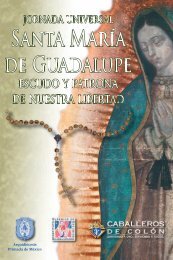Catholics and Capital Punishment - Knights of Columbus, Supreme ...
Catholics and Capital Punishment - Knights of Columbus, Supreme ...
Catholics and Capital Punishment - Knights of Columbus, Supreme ...
Create successful ePaper yourself
Turn your PDF publications into a flip-book with our unique Google optimized e-Paper software.
VVERITAS<br />
<strong>Catholics</strong> <strong>and</strong><br />
<strong>Capital</strong> <strong>Punishment</strong><br />
Father Augustine Judd, O.P.
The <strong>Knights</strong> <strong>of</strong> <strong>Columbus</strong> presents<br />
The Veritas Series<br />
“Proclaiming the Faith in the Third Millennium”<br />
<strong>Catholics</strong> <strong>and</strong><br />
<strong>Capital</strong> <strong>Punishment</strong><br />
BY<br />
FATHER AUGUSTINE JUDD, O.P.<br />
General Editor<br />
Father John A. Farren, O.P.<br />
Director <strong>of</strong> the Catholic Information Service<br />
<strong>Knights</strong> <strong>of</strong> <strong>Columbus</strong> <strong>Supreme</strong> Council
Nihil Obstat<br />
Censor Librorum<br />
Reverend Monsignor David Q. Liptak<br />
Imprimatur<br />
Daniel A. Cronin, S.T.D.<br />
Archbishop <strong>of</strong> Hartford<br />
November 8, 1999<br />
The Nihil Obstat <strong>and</strong> Imprimatur are <strong>of</strong>ficial declarations that a book or pamphlet is free<br />
<strong>of</strong> doctrinal or moral error. No implication is contained therein that those who have<br />
granted the Nihil Obstat <strong>and</strong> Imprimatur agree with the contents, opinions or statements<br />
expressed.<br />
Copyright © 2000 by <strong>Knights</strong> <strong>of</strong> <strong>Columbus</strong> <strong>Supreme</strong> Council. All rights reserved.<br />
Scripture selections are taken from the New American Bible, copyright © 1986 by the<br />
Confraternity <strong>of</strong> Christian Doctrine, Washington, D.C. 20017. Used with permission.<br />
All rights reserved.<br />
Texts taken from the Catechism <strong>of</strong> the Catholic Church for the United States <strong>of</strong> America,<br />
copyright © 1994 by the United States Catholic Conference Inc., Liberia Editrice<br />
Vaticana. All rights reserved.<br />
Excerpts from Vatican Council II: The Concilar <strong>and</strong> Post-Conciliar Documents, New Revised<br />
Edition edited by Austin Flannery, O.P., copyright © 1992, Costello Publishing<br />
Company, Inc., Northport, NY are used by permission <strong>of</strong> the publisher, all rights<br />
reserved. No part <strong>of</strong> these excerpts may be reproduced, stored in a retrieval system, or<br />
transmitted in any form or by any means-electronic, mechanical, photocopying,<br />
recording or otherwise, without express permission <strong>of</strong> Costello Publishing Company.<br />
Texts from the Code <strong>of</strong> Canon Law, Latin/English Edition, are used with permission,<br />
copyright © 1983 by the Canon Law Society <strong>of</strong> America, Washington, D.C.<br />
Cover: © PhotoDisc Inc., Getty Images. Prisoner at the door <strong>of</strong> his prison cell.<br />
No part <strong>of</strong> this book may be reproduced or transmitted in any form or by any means,<br />
electronic or mechanical, including photocopying, recording, or by information storage<br />
<strong>and</strong> retrieval system, without permission in writing from the publisher. Write:<br />
Catholic Information Service<br />
<strong>Knights</strong> <strong>of</strong> <strong>Columbus</strong> <strong>Supreme</strong> Council<br />
PO Box 1971<br />
New Haven, CT 06521-1971<br />
www.k<strong>of</strong>c.org/cis<br />
cis@k<strong>of</strong>c.org<br />
203-752-4267<br />
203-752-4018 fax<br />
Printed in the United States <strong>of</strong> America
CONTENTS<br />
INTRODUCTION . . . . . . . . . . . . . . . . . . . . . . . . . . . . . . . . . . . . . . . . . 5<br />
PART ONE: THE RIGHT TO IMPOSE CAPITAL PUNISHMENT. . . . . . . . . . 5<br />
Old Testament . . . . . . . . . . . . . . . . . . . . . . . . . . . . . . . . . . . 5<br />
The Gospels . . . . . . . . . . . . . . . . . . . . . . . . . . . . . . . . . . . . . 7<br />
Saint Paul’s Letter to the Romans . . . . . . . . . . . . . . . . . . . . . 9<br />
The Fathers <strong>of</strong> the Church . . . . . . . . . . . . . . . . . . . . . . . . . 10<br />
The Middle Ages . . . . . . . . . . . . . . . . . . . . . . . . . . . . . . . . 12<br />
Development in Thought after Aquinas . . . . . . . . . . . . . . . 13<br />
PART TWO: THE EXERCISE OF THE RIGHT TO IMPOSE<br />
CAPITAL PUNISHMENT . . . . . . . . . . . . . . . . . . . . . . . . . . . . . . . .14<br />
<strong>Capital</strong> <strong>Punishment</strong> as retribution . . . . . . . . . . . . . . . . . . . 15<br />
<strong>Capital</strong> <strong>Punishment</strong> as deterrence . . . . . . . . . . . . . . . . . . . . 15<br />
<strong>Capital</strong> <strong>Punishment</strong> as reform. . . . . . . . . . . . . . . . . . . . . . . 16<br />
PART THREE: THE MODERN APPLICATION OF CAPITAL PUNISHMENT . . 17<br />
Statements by Conferences <strong>of</strong> Bishops. . . . . . . . . . . . . . . . . 17<br />
Catechism <strong>of</strong> the Catholic Church . . . . . . . . . . . . . . . . . . . 18<br />
Pope John Paul II . . . . . . . . . . . . . . . . . . . . . . . . . . . . . . . . 20<br />
CONCLUSION . . . . . . . . . . . . . . . . . . . . . . . . . . . . . . . . . . . . . . . . . . . 21<br />
ABOUT THE AUTHOR . . . . . . . . . . . . . . . . . . . . . . . . . . . . . . . . . . . . . 22
INTRODUCTION<br />
One easily sees why the Catholic Church’s teaching on the<br />
morality <strong>of</strong> capital punishment confuses some. Unlike the moral<br />
issues <strong>of</strong> abortion or artificial contraception, the Church’s teaching<br />
on capital punishment can appear contradictory. On the one h<strong>and</strong>,<br />
Christian faith has always affirmed the sanctity <strong>of</strong> human life, from<br />
conception to natural death. Life is for God to give <strong>and</strong> take, rather<br />
than humans. On the other h<strong>and</strong>, the Church’s traditional teaching<br />
has also affirmed the legitimacy <strong>of</strong> executing a duly convicted<br />
criminal. Public statements by Catholic <strong>and</strong> other Christian leaders<br />
calling for the complete abolition <strong>of</strong> the death penalty add to the<br />
apparent confusion. The issue needs clarification so that one can<br />
better underst<strong>and</strong> what is <strong>and</strong> what is not Church teaching. Any<br />
attempt to provide this clarification must take into account two<br />
questions:<br />
1. Does society have the right to put a criminal to death for<br />
heinous crime? If so,<br />
2. Do the circumstances <strong>of</strong> the modern world warrant society’s<br />
exercise <strong>of</strong> that right?<br />
PART ONE: THE RIGHT TO IMPOSE CAPITAL<br />
PUNISHMENT<br />
Old Testament<br />
In answering the first question, the Church has always begun<br />
by turning to what God reveals to us in Sacred Scripture <strong>and</strong><br />
tradition. Unfortunately, appeals to Scripture for either the<br />
justification or the condemnation <strong>of</strong> capital punishment have<br />
- 5 -
yielded no firm conclusions. Both sides <strong>of</strong> the issue cite passages for<br />
support. For example, opponents note that the first murder in the<br />
Old Testament was not punished by death. For having slain Abel,<br />
the Lord cursed <strong>and</strong> banished Cain, but did not punish him with<br />
death. When Cain next said he was afraid that someone else would<br />
slay him because <strong>of</strong> his crime, the Lord assured him otherwise: “‘Not<br />
so! If any one slays Cain, vengeance shall be taken on him sevenfold.’<br />
And the Lord put a mark on Cain, lest any who came upon him<br />
should kill him” (Genesis 4:15). But as proponents <strong>of</strong> capital<br />
punishment are quick to point out, there soon seems to be a change<br />
in attitude. After Noah left the Ark, for instance, the Lord blessed<br />
him <strong>and</strong> said to him: “Whoever sheds the blood <strong>of</strong> man, by man<br />
shall his blood be shed; for God made man in his own image”<br />
(Genesis 9:6).<br />
Still later, when the Lord gives Moses the Ten Comm<strong>and</strong>ments<br />
<strong>and</strong> the ordinances in conjunction with them, the comm<strong>and</strong>ment<br />
against killing is not absolute. We learn:<br />
Whoever strikes a man so that he dies shall be put to death….<br />
If a man willfully attacks another to kill him treacherously, you<br />
shall take him from my altar, that he may die…. Whoever<br />
strikes his father or mother shall be put to death…. Whoever<br />
steals a man, whether he sells him or is found in possession <strong>of</strong><br />
him, shall be put to death…. Whoever curses his father or his<br />
mother shall be put to death (Exodus 21:12-17).<br />
Death was also enjoined as punishment for many other <strong>of</strong>fenses<br />
that no one today would consider capital. Religious <strong>of</strong>fenses like<br />
idolatry, blasphemy, apostasy, magic, necromancy, <strong>and</strong> various<br />
violations <strong>of</strong> the Sabbath <strong>and</strong> cultic life <strong>of</strong> the people all merited<br />
death as punishment. Incest, adultery, bestiality <strong>and</strong> homosexual<br />
activity were sexual <strong>of</strong>fenses punishable by death. The Israelites saw<br />
the need for death in these cases because they held them to be<br />
violations <strong>of</strong> the Covenant, the alliance between God <strong>and</strong> his people.<br />
To preserve this alliance, its transgressor had to be excluded from<br />
the community. Of course, death poignantly emphasized this<br />
- 6 -
exclusion, <strong>and</strong> the most common method <strong>of</strong> execution (stoning by a<br />
crowd) underscored the communal nature <strong>of</strong> the act <strong>of</strong> exclusion.<br />
That the executions would occur under the direction <strong>of</strong> the “state”<br />
did not present itself as a problem for the Israelites. In their<br />
underst<strong>and</strong>ing <strong>of</strong> God’s Providence, an underst<strong>and</strong>ing inherited for<br />
the most part by Christians as well, the power <strong>of</strong> life <strong>and</strong> death is<br />
God’s alone. He is the source <strong>and</strong> custodian <strong>of</strong> all order, including<br />
the juridical. Therefore, a violator <strong>of</strong> the Covenant that the Lord had<br />
made with his people could be put to death by his authority <strong>and</strong> in<br />
his name.<br />
At the same time, the Old Testament discloses certain instances<br />
where even in capital cases the Lord calls for restraint <strong>and</strong> mercy. As<br />
the Lord said to Ezekiel: “I have no pleasure in the death <strong>of</strong> the<br />
wicked, but that the wicked turn back from his ways <strong>and</strong> live; turn<br />
back, turn back from your evil ways; for why will you die, O house<br />
<strong>of</strong> Israel?” (Ezekiel 33:11) Yet even in instances like these the Lord<br />
places no absolute restriction on the community’s power to execute<br />
a justly condemned criminal.<br />
The Gospels<br />
Neither does the New Testament clearly proscribe or condone<br />
the use <strong>of</strong> capital punishment. Certainly, Jesus called upon his<br />
disciples to be merciful. In considering his words <strong>and</strong> actions, we<br />
note his concern to assure that the interior motivations <strong>of</strong> his<br />
disciples did not arise from the spirit <strong>of</strong> vengeance. This even<br />
includes the limited vengeance that informs so many Old Testament<br />
injunctions about the use <strong>of</strong> capital punishment. In the Sermon on<br />
the Mount, Jesus established <strong>and</strong> explains the New Law. He enjoins<br />
his followers to renounce not only evil actions, but also the evil<br />
inclinations from which they arise. “You have heard that it was said<br />
to the men <strong>of</strong> old, ‘You shall not kill; <strong>and</strong> whoever kills shall be<br />
liable to judgment.’ But I say to you that whoever is angry with his<br />
brother shall be liable to judgment” (Matthew 5:21-22). Moreover,<br />
the New Law erases all limits to the love the disciples <strong>of</strong> Jesus must<br />
bear for others. Consider the following passage:<br />
- 7 -
You have heard that it was said, “An eye for an eye <strong>and</strong> a tooth<br />
for a tooth.” But I say to you: do not resist one who is evil. But<br />
if any one strikes you on the right cheek, turn to him the other<br />
also…. You have heard that it was said, “You shall love your<br />
neighbor <strong>and</strong> hate your enemy.” But I say to you: love your<br />
enemies <strong>and</strong> pray for those who persecute you (Matthew 5:38-39,<br />
43-44).<br />
Since the New Law makes such a radical departure from what<br />
passes for common wisdom, some have hastily <strong>and</strong> mistakenly<br />
argued that loving one’s enemies sets aside any right to resort to the<br />
death penalty for self-defense.<br />
Others cite the parable <strong>of</strong> the wheat <strong>and</strong> the weeds (Matthew<br />
13:24-30) to argue against the death penalty. In this parable the<br />
wheat <strong>and</strong> the weeds represent the righteous <strong>and</strong> the evildoers. Both<br />
are allowed to coexist until the end <strong>of</strong> time, <strong>and</strong> only then will the<br />
evildoers be punished. The point that opponents <strong>of</strong> the death penalty<br />
are trying to make with this parable <strong>and</strong> with the Sermon on the<br />
Mount is that God alone has the prerogative to punish those<br />
committing grave <strong>of</strong>fenses, <strong>and</strong> human beings do not. Indeed, as we<br />
will see, some <strong>of</strong> the early Church Fathers have held similar opinions.<br />
However, the suggestion that God dem<strong>and</strong>s from us absolute nonresistance<br />
creates a false division between divine <strong>and</strong> natural law<br />
since the latter has always allowed for self-preservation <strong>and</strong> resistance<br />
under attack. Instead, a correspondence exists between the two.<br />
Natural law subsists <strong>and</strong> flourishes under divine law, which in turn<br />
perfects it. Therefore, divine law disposes <strong>of</strong> no part <strong>of</strong> the natural<br />
law, including presumably the right to self-defense.<br />
If the words <strong>of</strong> Jesus do not in themselves settle the question <strong>of</strong><br />
capital punishment’s legitimacy, neither do his actions. The<br />
example <strong>of</strong> the woman caught in adultery is typical. Her accusers<br />
present her to Jesus <strong>and</strong> say to him, “Teacher, this woman has been<br />
caught in the act <strong>of</strong> adultery. Now the law <strong>of</strong> Moses comm<strong>and</strong>ed us<br />
to stone such. What do you say about her?” (John 8:4-5) Jesus does<br />
not say to them, “Stone her,” but instead makes his well-known<br />
- 8 -
eply, “Let him who is without sin among you be the first to throw<br />
a stone at her” (John 8:7). Opponents <strong>of</strong> the death penalty see this<br />
as an implicit rejection by Jesus <strong>of</strong> the community’s right to execute<br />
the condemned. Yet the details <strong>of</strong> the incident do not conclusively<br />
bear out that interpretation. Jesus does not say the woman does not<br />
deserve stoning. He merely suggests that carrying out the sentence<br />
by those guilty <strong>of</strong> other <strong>of</strong>fenses is inappropriate. His words to the<br />
woman, “Go, <strong>and</strong> do not sin again” (John 8:11), suggest neither her<br />
innocence nor the unsuitability <strong>of</strong> her punishment. They imply only<br />
that she was forgiven.<br />
The events surrounding Jesus’ own death sentence do not settle<br />
the issue, either. When Pilate informs Jesus he has the power to<br />
release him or have him crucified, Jesus answers: “You would have<br />
no power over me unless it had been given you from above” (John<br />
19:11). Proponents <strong>of</strong> capital punishment cite this passage for<br />
support, arguing that Jesus affirms the legitimate but subsidiary<br />
power <strong>of</strong> the civil arm to execute <strong>of</strong>fenders. However, this is<br />
probably reading too much into the text. Strictly speaking, Jesus’<br />
words refer only to the divine origin <strong>of</strong> civil power itself, without<br />
<strong>of</strong>fering a particular judgment regarding the morality <strong>of</strong> capital<br />
punishment. Similarly, Jesus does not affirm or reject the statement<br />
<strong>of</strong> the good thief crucified next to him: “We are receiving the due<br />
reward <strong>of</strong> our deeds” (Luke 23:41).<br />
Saint Paul’s Letter to the Romans<br />
Unlike the gospels, Saint Paul’s Letter to the Romans addresses<br />
directly the issue <strong>of</strong> capital punishment <strong>and</strong> the community’s role in<br />
its implementation. Having just mentioned the duties <strong>and</strong><br />
obligations <strong>of</strong> the Christian disciple, Saint Paul <strong>of</strong>fers the following<br />
advice:<br />
“Let every person be subject to the governing authorities. For<br />
there is no authority except from God, <strong>and</strong> those that exist have<br />
been instituted by God. Therefore, he who resists the authorities<br />
resists what God has appointed, <strong>and</strong> those who resist will incur<br />
- 9 -
judgment. For rulers are not a terror to good conduct, but to<br />
bad. Would you have no fear <strong>of</strong> him who is in authority? Then<br />
do what is good, <strong>and</strong> you will receive his approval, for he is<br />
God’s servant for your good. But if you do wrong, be afraid, for<br />
he does not bear the sword in vain; he is the servant <strong>of</strong> God to execute his<br />
wrath on the wrongdoer” (Romans 13:1-4, emphasis added).<br />
Some see in Saint Paul’s statement the recognition <strong>of</strong> a lawful <strong>and</strong><br />
divinely sanctioned power held by civil <strong>of</strong>ficials to pronounce <strong>and</strong><br />
carry out a capital sentence. Without doubt, Paul accepts the<br />
general authority <strong>of</strong> the civil ruler. He even accepts the authority <strong>of</strong><br />
the civil ruler <strong>of</strong> his times, <strong>of</strong> first century Hellenistic culture, to<br />
apply capital punishment. But the acknowledgement <strong>of</strong> this<br />
authority does not automatically suggest a reflection on the<br />
morality <strong>of</strong> capital punishment in general, or, in particular, on the<br />
power to administer it. At most, Saint Paul simply accepts a ruler’s<br />
authority to carry out capital punishment, without commenting on<br />
its morality. Certainly his toleration need not imply his approval.<br />
The Fathers <strong>of</strong> the Church<br />
Neither did the Church in the post-apostolic age establish a clear<br />
consensus regarding capital punishment. The views <strong>of</strong> this period<br />
range from accommodation to limited acceptance to outright<br />
prohibition <strong>of</strong> the practice. Saint Clement <strong>of</strong> Alex<strong>and</strong>ria (c. 150-215)<br />
made the first attempt to devise a theory justifying capital<br />
punishment. He justified his position from the st<strong>and</strong>point <strong>of</strong> selfdefense.<br />
While seeing the reform <strong>of</strong> the wrongdoer as the primary<br />
purpose <strong>of</strong> punishment, he nevertheless admitted that one could<br />
become evil beyond any expectation for reform or “cure.” In this case,<br />
he argued the guilty might be put to death to prevent further<br />
evildoing. While making his point, he was the first to argue that an<br />
evildoer is like an infected limb that plagues the body. If it cannot be<br />
cured, the physician (the judge <strong>and</strong> executioner) must remove it to<br />
prevent the infection from harming the rest <strong>of</strong> the body (society).<br />
Citing Old Testament passages, Saint Clement also justified such a<br />
death as a deterrent to other evildoers.<br />
- 10 -
Other Fathers accepted capital punishment as a civil reality, but<br />
condemned Christian participation in it. Saint Athenagoras (d. 190)<br />
wrote both <strong>of</strong> the possibility <strong>of</strong> justifying capital punishment <strong>and</strong> <strong>of</strong><br />
the unseemliness <strong>of</strong> Christian cooperation in it. Without<br />
commenting upon the legitimacy <strong>of</strong> its application, Tertullian (c.<br />
160-220) inveighed against its severity. He accepted the public<br />
authority’s “power <strong>of</strong> the sword,” while disapproving <strong>of</strong> Christian<br />
involvement in its exercise. Origen (c. 185-254) likewise took for<br />
granted the ruler’s power to inflict the death penalty. For him, one<br />
could suffer a greater penalty than death by execution. He argued<br />
that death is a lesser penalty than that <strong>of</strong> grave guilt <strong>and</strong> eternal<br />
damnation. Still, with Tertullian, he was critical <strong>of</strong> the abuses <strong>of</strong><br />
capital punishment <strong>and</strong> decried Christian participation in it.<br />
In the fourth <strong>and</strong> fifth centuries, as Christianity was first<br />
tolerated <strong>and</strong> then promoted throughout the Roman Empire,<br />
thought on Christian participation in capital punishment evolved.<br />
Christians increasingly found themselves in public <strong>of</strong>fice holding<br />
power over life <strong>and</strong> death. Saint John Chrysostom (c. 349-407), for<br />
instance, accepted that the Christian Emperor Theodosius had this<br />
power, even if Chrysostom thought its application on occasion<br />
severe or indiscriminate. Although Saint Augustine (354-430) did<br />
not say much on the subject, he recognized certain situations in<br />
which a Christian ruler, without incurring the guilt <strong>of</strong> murder,<br />
might put someone to death. For example, in his famous work, The<br />
City <strong>of</strong> God, he wrote:<br />
There are some exceptions made by the divine authority to<br />
its own law, that men may not be put to death. These<br />
exceptions are <strong>of</strong> two kinds, being justified either by a<br />
general law, or by a special commission granted for a time<br />
to some individual. And in this latter case, he to whom<br />
authority is delegated, <strong>and</strong> who is but the sword in the h<strong>and</strong><br />
<strong>of</strong> him who uses it, is not himself responsible for the death<br />
he deals. And accordingly, they who have waged war in<br />
obedience to the divine comm<strong>and</strong>, or in conformity with<br />
- 11 -
His laws have represented in their persons the public justice<br />
or the wisdom <strong>of</strong> government, <strong>and</strong> in this capacity have put<br />
to death wicked men; such persons have by no means<br />
violated the comm<strong>and</strong>ment, ‘Thou shalt not kill’ (Book I,<br />
chapter 21).<br />
Even so, Saint Augustine recommended that the legitimate<br />
exercise <strong>of</strong> capital punishment be put aside in favor <strong>of</strong> less-severe<br />
sentences in particular instances. He never wrote that punishment<br />
should be withheld entirely from wrongdoers. Indeed, Saint<br />
Augustine believed the fear <strong>of</strong> punishment useful in two regards.<br />
Out <strong>of</strong> fear <strong>of</strong> bodily punishment, it first <strong>of</strong> all deters evildoers from<br />
their actions. It then leads to a more enlightened fear, the fear <strong>of</strong><br />
<strong>of</strong>fending against the love <strong>of</strong> God.<br />
Lactantius (d. 317) took a view different from those who<br />
admitted some possible legitimacy for capital punishment. For<br />
Lactantius the Fifth Comm<strong>and</strong>ment, “Thou shalt not kill,”<br />
admitted <strong>of</strong> no exception. Although the Church would never come<br />
to accept Lactantius’ view <strong>of</strong> the Fifth Comm<strong>and</strong>ment as an absolute<br />
prohibition <strong>of</strong> capital punishment, his influence would continue to<br />
be felt in theological reflection on the issue down to our day.<br />
The Middle Ages<br />
By the 12 th century, Christians widely accepted the civil power’s<br />
right to put evildoers to death. Indeed, Pope Innocent III (c. 1160-<br />
1216) condemned certain heretics <strong>of</strong> the Middle Ages for, among<br />
other things, denying this right. But while the Church affirmed the<br />
secular power <strong>of</strong> the sword, it also quickly conditioned this right. It<br />
forbade the arbitrary or indiscriminate use <strong>of</strong> this power. Secular<br />
authorities could employ it only for justice, not hatred. Moreover, in<br />
1215 the Fourth Lateran Council forbade the direct participation <strong>of</strong><br />
all clerics in any capital criminal case or process.<br />
Saint Thomas Aquinas (1225-1274), perhaps the greatest<br />
theologian <strong>of</strong> Christian history, made the most influential medieval<br />
contribution to Christian thought on the death penalty. In fact, even<br />
- 12 -
in our own day we come across this Dominican friar’s mark on the<br />
subject. In his two greatest works, the Summa Contra Gentiles <strong>and</strong> the<br />
Summa Theologiae, Saint Thomas reiterated <strong>and</strong> further developed<br />
the medical analogy already drawn out by Clement <strong>of</strong> Alex<strong>and</strong>ria:<br />
It is lawful to kill brute animals inasmuch as they are naturally<br />
ordered to the use <strong>of</strong> men, as imperfect to perfect. Every part is<br />
ordered to whole as imperfect to perfect <strong>and</strong>, so, every part is<br />
naturally for the whole. Consequently we see that if the<br />
amputation <strong>of</strong> a member – say one that is putrid or corrupting<br />
the other members – is required for the health <strong>of</strong> the whole<br />
body, then it is laudably <strong>and</strong> salubriously cut <strong>of</strong>f. Now an<br />
individual person is compared to the whole community as part<br />
to whole; <strong>and</strong> therefore if a man is a danger to the community<br />
<strong>and</strong> a corrupting element because <strong>of</strong> some sin, then he is<br />
lawfully <strong>and</strong> salubriously killed, that the common good be<br />
preserved (ST II-II, q. 64, a. 2).<br />
Saint Thomas uses language here that seems rather stark,<br />
because it suggests the individual’s rigid subordination to society.<br />
However, other aspects <strong>of</strong> his thought mitigate this harshness. For<br />
example, Saint Thomas pointed out that only a public authority<br />
could judge <strong>and</strong> execute a serious <strong>of</strong>fender where society’s defense is<br />
a stake, <strong>and</strong> where the <strong>of</strong>fender’s reform is not expected. Saint<br />
Thomas left no room for private vigilantism. Finally, Saint Thomas<br />
reminded his readers in places <strong>of</strong> the retributive <strong>and</strong> medicinal<br />
qualities <strong>of</strong> punishments short <strong>of</strong> the death penalty.<br />
Development in Thought after Aquinas<br />
Following Saint Thomas, Catholic moral theologians down to<br />
our own day continued to qualify the situations where the death<br />
penalty could be applied. Eventually, a consensus emerged which<br />
formulated three general prerequisites for applying the death penalty:<br />
1. Only a legitimate public authority can impose it.<br />
2. The penalty must correspond to the gravity <strong>of</strong> the crime.<br />
3. Moral certainty <strong>of</strong> the wrongdoer’s guilt must exist.<br />
- 13 -
The first condition allows only a legitimate public authority to<br />
impose the death penalty. Its fittingness is apparent if one makes the<br />
reasonable assumption that a wrongdoer threatens public safety. It<br />
then follows that the one who is primarily responsible for public<br />
order <strong>and</strong> the common good ought to be the one to carry out the<br />
execution. This condition clearly means to exclude both individual<br />
<strong>and</strong> mass acts <strong>of</strong> vengeance, even if the <strong>of</strong>fender’s guilt is proven.<br />
Such acts include, for instance, a mob lynching or the killing <strong>of</strong> an<br />
adulterous spouse, still common in some countries today. For this<br />
reason, the lawful public authority must always be formally invoked<br />
at an execution.<br />
The second condition for lawfully applying the death penalty<br />
holds that it must correspond to the gravity <strong>of</strong> the crime. While a<br />
broader underst<strong>and</strong>ing <strong>of</strong> grave criminal activity existed in the past,<br />
in peacetime nowadays the death penalty is chiefly reserved for the<br />
crime <strong>of</strong> murder (there are currently some provisions in U.S. law to<br />
execute convicted major drug felons). This presumes that the direct<br />
taking <strong>of</strong> innocent human life does enough severe harm to society to<br />
warrant the removal <strong>of</strong> the <strong>of</strong>fender by execution.<br />
As a final condition for applying the death penalty, moral<br />
certainty must exist about the guilt <strong>of</strong> the accused. In normal<br />
circumstances this means the accused has the right to a reasonable<br />
defense in fair trial. Most would also agree that a confession <strong>of</strong> guilt<br />
to a capital crime need not be obtained for the public authority to<br />
arrive at the moral certitude required to sentence a criminal to<br />
death. In recent years critics <strong>of</strong> the death penalty have argued that<br />
this condition is not being fulfilled due to several biases still present<br />
in the legal system.<br />
PART TWO: THE EXERCISE OF THE RIGHT TO IMPOSE<br />
CAPITAL PUNISHMENT<br />
Up to this point, we have examined only whether, according to<br />
Catholic teaching, society has the right to impose capital<br />
punishment. There is another pertinent question that Catholic<br />
- 14 -
teaching considers, namely, “Should society exercise that right?”<br />
Those answering in the affirmative place their answer within the<br />
framework <strong>of</strong> the general nature <strong>and</strong> purpose <strong>of</strong> all punishment, <strong>and</strong><br />
traditionally appeal to one or more <strong>of</strong> the three following<br />
arguments:<br />
1. <strong>Capital</strong> punishment as retribution: it restores the balance <strong>of</strong><br />
justice by inflicting punishment in exchange for the harm done to<br />
an individual <strong>and</strong> society.<br />
In general, one underst<strong>and</strong>s “retribution” to mean rendering to<br />
a convicted criminal what is his or her “due,” through the<br />
deprivation <strong>of</strong> life, liberty <strong>and</strong>/or property. The retribution thus<br />
meted out simply restores “the balance <strong>of</strong> justice.” For this reason,<br />
retribution earns its description as an “absolute theory” <strong>of</strong><br />
punishment. Unlike “relative theories” <strong>of</strong> punishment, such as<br />
deterrence <strong>and</strong> reform, the case for retribution does not rely upon<br />
less immediate reasons. Opponents <strong>of</strong> the retributive theory <strong>of</strong><br />
punishment criticize it as a thinly veiled justification for revenge<br />
<strong>and</strong> vindictiveness.<br />
As applied to capital punishment in particular, the retributive<br />
theory presents some difficulties. One is the fact that capital<br />
punishment cannot be applied in degrees. One cannot put a person<br />
partially to death. Yet a convict’s culpability for a capital crime<br />
<strong>of</strong>ten does admit <strong>of</strong> degrees. And even if legal guidelines exist for<br />
assessing the culpability <strong>of</strong> a convicted criminal in potentially<br />
capital cases, critics make the strong argument that they are neither<br />
perfectly nor equally applied.<br />
2. <strong>Capital</strong> punishment as deterrence: the threat <strong>of</strong> death<br />
discourages someone from committing heinous acts against<br />
individuals <strong>and</strong> society.<br />
Supporters <strong>of</strong> the deterrent value <strong>of</strong> punishment argue for its<br />
effectiveness ins<strong>of</strong>ar as the penalty inflicted dissuades both the<br />
wrongdoer from repeating the <strong>of</strong>fense <strong>and</strong> someone else from<br />
imitating the wrongdoing. For obvious reasons, only the latter<br />
- 15 -
consideration applies in the case <strong>of</strong> capital punishment. Even so,<br />
critics dispute the deterrent capability <strong>of</strong> capital punishment. They<br />
say capital punishment may even harden a criminal. It may drive<br />
him or her to further acts <strong>of</strong> desperation while attempting to avoid<br />
arrest <strong>and</strong> the prospect <strong>of</strong> execution. Nor will capital punishment<br />
effectively deter murders committed “in the heat <strong>of</strong> passion,” or by<br />
the mentally ill, or by those under the influence <strong>of</strong> drugs. Critics<br />
note that the <strong>of</strong>ten-sensationalized ambiance surrounding public<br />
executions trivializes capital punishment <strong>and</strong> therefore lessens its<br />
deterrent potential. At the same time, they wonder how executions<br />
performed in the presence <strong>of</strong> just a few witnesses can publicly deter<br />
potential wrongdoers.<br />
3. <strong>Capital</strong> punishment as reform: the threat <strong>of</strong> imminent death<br />
can spur the conversion or repentance <strong>of</strong> the convicted, aptly<br />
preparing him or her for the next life.<br />
This final justification for punishment assumes that it can<br />
successfully provide the context for a wrongdoer’s true conversion,<br />
repentance, <strong>and</strong> resolve to refrain from further evil deeds.<br />
Proponents <strong>of</strong> the death penalty claim it can do the same. Indeed,<br />
they even assert that such occasions would not present themselves so<br />
<strong>of</strong>ten were it not for the reality <strong>of</strong> impending death. Critics counter<br />
by noting the death penalty is merely a possible occasion for<br />
conversion. Therefore, they see the argument that the death penalty<br />
can encourage an evildoer’s reform as tangential at best. And even if<br />
the threat <strong>of</strong> death brings about a change <strong>of</strong> heart, they wonder what<br />
is served by then putting a criminal to death. It does not make him<br />
or her virtuous. Execution poignantly eliminates a converted<br />
criminal’s period <strong>of</strong> earthly grace <strong>and</strong> penitence, since one’s lifetime<br />
is the only period <strong>of</strong> “probation” one can enjoy. There are certainly<br />
some cases <strong>of</strong> unexecuted murderers who later repented <strong>and</strong> became<br />
virtuous individuals. The contrite murderer <strong>of</strong> Saint Peter <strong>of</strong> Verona<br />
(1206-1252), for example, later became a Dominican brother <strong>and</strong><br />
was referred to as “the blessed Carino” by those who knew him.<br />
- 16 -
PART THREE: THE MODERN APPLICATION OF<br />
CAPITAL PUNISHMENT<br />
Authoritative Catholic teaching draws upon all that has been<br />
discussed thus far. It distinguishes between society’s right to inflict<br />
capital punishment, <strong>and</strong> the need to do so. While it does not deny<br />
the death penalty’s proper lawfulness under certain conditions, it<br />
does oppose its modern application, given the particular<br />
circumstances <strong>of</strong> our culture <strong>and</strong> our times.<br />
Statements by Conferences <strong>of</strong> Bishops<br />
Various national conferences <strong>of</strong> Catholic bishops defend this<br />
teaching <strong>of</strong> the Church. The bishops <strong>of</strong> the United States <strong>and</strong> <strong>of</strong> the<br />
Philippines, for example, question the justification for capital<br />
punishment “under present circumstances.” The Filipino bishops<br />
address themselves to the three justifications for capital punishment<br />
outlined above. They deny first its usefulness as a basis for reform,<br />
since death automatically eliminates any possibility the convict has<br />
to render “creative compensation.” They also question whether the<br />
threat <strong>of</strong> impending death ought to be the chief premise for God’s<br />
grace to act upon the heart <strong>of</strong> a condemned criminal. Neither does<br />
the argument for deterrence convince the Filipino bishops, who note<br />
the inconclusive nature <strong>of</strong> the evidence in regard to the death<br />
penalty. Finally, while affirming the legitimate general retributive<br />
effect <strong>of</strong> punishment, they wonder whether achieving this effect<br />
would require or justify the execution <strong>of</strong> a criminal. While certainly<br />
not denying that society should be protected from criminals, they<br />
observe that vindictiveness can never be the basis for a Christian<br />
approach to punishment.<br />
Besides scrutinizing the death penalty’s justification, the<br />
Filipino bishops stress the difficulty <strong>of</strong> achieving its fair application.<br />
When it comes to sentencing, the available data show that a<br />
convict’s socio-economic status, gender, <strong>and</strong> race still seem to make<br />
a difference between life <strong>and</strong> death. Given its irreversibility, the<br />
- 17 -
execution <strong>of</strong> a wrongfully convicted person remains an especially<br />
unnerving possibility as well.<br />
On their part, the U.S. bishops try to show the harmony<br />
between the abolition <strong>of</strong> capital punishment <strong>and</strong> certain Christian<br />
values. Abolition, they maintain, shows a way to break the cycle <strong>of</strong><br />
violence that afflicts the modern world. It reaffirms the Church’s<br />
teaching on “the unique worth <strong>and</strong> dignity <strong>of</strong> each human person<br />
from the moment <strong>of</strong> conception, a creature made in the image <strong>and</strong><br />
likeness <strong>of</strong> God” (U.S. Bishops, “Statement on <strong>Capital</strong><br />
<strong>Punishment</strong>,” Origins, 27 Nov. 1980, p. 37). Along this line <strong>of</strong><br />
thought, the Filipino bishops <strong>of</strong>fer a particularly helpful insight.<br />
They reject the classic notion outlined above comparing a criminal’s<br />
execution to the removal <strong>of</strong> a diseased organ. They observe:<br />
A human being is not only a member <strong>of</strong> society as an organ is<br />
a member <strong>of</strong> a living body. While a human being must live for<br />
the good society, society exists in order to promote the good <strong>of</strong><br />
the individual human being. A human being has a value in<br />
himself/herself <strong>and</strong> is not the goal <strong>and</strong> purpose <strong>of</strong> society in a<br />
way that a limb or organ is not the goal <strong>and</strong> purpose <strong>of</strong> the<br />
human body (“Restoring the Death Penalty: ‘A Backward<br />
Step,’” Catholic International, 15-31 Oct. 1992, Vol. 3, No. 18,<br />
pp. 886-87).<br />
The Filipino bishops also insist that while no one ought to<br />
equate criminals convicted <strong>of</strong> capital <strong>of</strong>fenses with the unborn, the<br />
aged, or the infirm, abolition would nevertheless bolster the<br />
consistent ethic <strong>of</strong> life which the Church proclaims. Finally, the<br />
bishops contend the abolition <strong>of</strong> capital punishment would follow<br />
the merciful teaching <strong>and</strong> example <strong>of</strong> Jesus, who gave his life for<br />
wrongdoers.<br />
Catechism <strong>of</strong> the Catholic Church<br />
The Catechism <strong>of</strong> the Catholic Church published during the<br />
pontificate <strong>of</strong> Pope John Paul II remains a definitive source <strong>of</strong> recent<br />
authoritative Catholic teaching on capital punishment (another<br />
- 18 -
significant source is Evangelium Vitae). In its discussion <strong>of</strong> the Fifth<br />
Comm<strong>and</strong>ment, the Catechism considers the topic in light both <strong>of</strong><br />
the right to legitimate defense <strong>and</strong> <strong>of</strong> the effects <strong>of</strong> punishment (nn.<br />
2263-67). Regarding the first, it distinguishes between “the<br />
legitimate defense <strong>of</strong> persons <strong>and</strong> societies” <strong>and</strong> intentional murder.<br />
Legitimate defense is neither an exception to, nor a dispensation<br />
from, intentional murder. It is in a different category altogether.<br />
The virtuous love one bears oneself serves as a basis for morality. No<br />
one acting according to this love in defense <strong>of</strong> one’s own life would<br />
incur the guilt <strong>of</strong> murder when dealing an aggressor a mortal blow.<br />
Moreover, legitimate defense <strong>of</strong>ten extends beyond one’s own<br />
person. The defense <strong>of</strong> other lives, the common good, <strong>and</strong> the family<br />
are not only rights, but they are solemn duties as well for those to<br />
whom it has been entrusted. “Legitimate defense can be not only a<br />
right but a grave duty for one who is responsible for the lives <strong>of</strong><br />
others. The defense <strong>of</strong> the common good requires that an unjust<br />
aggressor be rendered unable to cause harm” (n. 2265).<br />
The Catechism also considers the effects <strong>of</strong> punishment in<br />
addressing the question <strong>of</strong> the death penalty. It affirms that the chief<br />
effect <strong>of</strong> punishment must remain the correction <strong>of</strong> the upheaval<br />
caused by an <strong>of</strong>fense. In other words, restoration <strong>of</strong> societal order is<br />
paramount. By suggesting that punishment may aid the atonement<br />
<strong>of</strong> a criminal who accepts it as just, the Catechism further<br />
acknowledges its corrective value.<br />
Finally, the Catechism specifies what the legitimate defense <strong>of</strong><br />
the common good <strong>and</strong> the purpose <strong>of</strong> punishment imply regarding<br />
the death penalty. It states: “Assuming that the guilty party’s<br />
identity <strong>and</strong> responsibility have been fully determined, the<br />
traditional teaching <strong>of</strong> the Church does not exclude recourse to the<br />
death penalty, if this is the only possible way <strong>of</strong> effectively<br />
defending human lives against the unjust aggressor” (n. 2267).<br />
Thus, the Catechism affirms the right <strong>of</strong> civil society to inflict<br />
the death penalty. In explaining the right, however, it adds a very<br />
important caveat: “If… non-lethal means are sufficient to defend <strong>and</strong><br />
- 19 -
protect people’s safety from the aggressor, authority will limit itself<br />
to such means, as these are more in keeping with the concrete<br />
conditions <strong>of</strong> the common good <strong>and</strong> more in conformity with the<br />
dignity <strong>of</strong> the human person” (n. 2267).<br />
Pope John Paul II<br />
Besides the teaching <strong>of</strong> bishops <strong>and</strong> the Church’s catechetical<br />
teaching, Papal authority also plays a most instructive role in<br />
elaborating Catholic teaching on capital punishment. Particularly<br />
important is Evangelium Vitae, Pope John Paul II’s encyclical on the<br />
dignity <strong>of</strong> human life. In the encyclical, the Pope elaborates much<br />
<strong>of</strong> what the bishops <strong>and</strong> the Catechism present. With them, the pope<br />
reaffirms the validity both <strong>of</strong> legitimate defense <strong>and</strong> <strong>of</strong> the purposes<br />
<strong>of</strong> punishment. The latter redress the disorder an <strong>of</strong>fense has caused,<br />
defend public order, <strong>and</strong> guarantee public safety. When addressing<br />
the question <strong>of</strong> whether the execution <strong>of</strong> a wrongdoer does these<br />
things, however, the Pope’s teaching is quite explicit. He writes:<br />
It is clear that for these purposes to be achieved, the nature <strong>and</strong><br />
extent <strong>of</strong> the punishment must be carefully evaluated <strong>and</strong><br />
decided upon, <strong>and</strong> ought not go to the extreme <strong>of</strong> executing the<br />
<strong>of</strong>fender except in cases <strong>of</strong> absolute necessity: in other words,<br />
when it would not be possible otherwise to defend society. Today<br />
however, as a result <strong>of</strong> steady improvements in the organization<br />
<strong>of</strong> the penal system, such cases are very rare if not practically<br />
nonexistent (Evangelium Vitae, 56, emphasis added).<br />
John Paul II does not deny the traditional teaching regarding<br />
the proper legitimacy <strong>of</strong> the death penalty. Neither does he deny the<br />
legitimacy <strong>of</strong> punishment in general. Given the particular<br />
circumstances <strong>of</strong> our culture, however, he does oppose its modern<br />
application. Here the Holy Father further clarifies the distinction<br />
between the state’s legitimate right to execute under certain<br />
circumstances <strong>and</strong> the need to exercise that right in today’s world.<br />
What gives the state its right to perform an execution is not the<br />
degree <strong>of</strong> harm a crime inflicts (although a heinous act remains a<br />
- 20 -
prerequisite in capital cases), but rather the inability <strong>of</strong> society to<br />
protect itself by any other means. According to the Holy Father, a<br />
society’s inability to protect itself by any other means is the<br />
determining factor in the decision to execute a criminal. Since our<br />
society can remove those guilty <strong>of</strong> serious <strong>of</strong>fenses by means <strong>of</strong> life<br />
imprisonment, the Holy Father judges as negligible society’s need<br />
to use the death penalty. In short, inflicting capital punishment<br />
when it is not necessary would transgress Catholic teaching. Pope<br />
John Paul II’s opposition to the use <strong>of</strong> the death penalty is,<br />
therefore, a legitimate exercise <strong>of</strong> his pastoral leadership as the Vicar<br />
<strong>of</strong> Christ on earth.<br />
CONCLUSION<br />
Catholic teaching on capital punishment is an opportunity to<br />
examine our own attitudes. While we must show compassion for the<br />
victims <strong>of</strong> crime <strong>and</strong> support society’s legitimate <strong>and</strong> just selfdefense,<br />
in Christ we are not free to direct revenge or hate toward<br />
anyone. This includes those guilty <strong>of</strong> criminal wrongdoing.<br />
Christian charity must not only be exercised with prudence, but also<br />
shown to all.<br />
- 21 -
ABOUT THE AUTHOR<br />
Father Augustine Judd, O.P., S.T.L. teaches Christology <strong>and</strong><br />
the Development <strong>of</strong> Western Civilization at Providence College,<br />
Providence, RI. A noted speaker, he has worked extensively with<br />
pro-life organizations in Washington, D.C., <strong>and</strong> in other cities. In<br />
this insightful study, Father Judd carefully details the Church’s<br />
teaching on capital punishment <strong>and</strong> the sanctity <strong>of</strong> human life.<br />
- 22 -

















